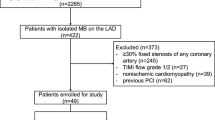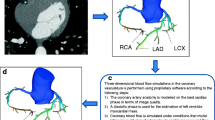Abstract
In myocardial bridging (MB) a segment of the coronary artery is covered by the myocardium. MB can be seen as a systolic compression by invasive coronary angiography (ICA) or as an intramural course by computed tomography angiography (CTA). Intramural course is a common incidental finding in CTA studies. Only minority of the bridging segments are associated with systolic compression causing a possible impairment of myocardial perfusion. The relationship between myocardial blood flow and MB is complex and poorly evaluated by anatomic imaging. Furthermore, provocation tests are frequently needed to uncover systolic compression. Fractional flow reserve can be used to assess the hemodynamic significance of MB. Nuclear perfusion imaging can demonstrate flow abnormalities associated with MB. Stress echocardiography can demonstrate ischemic wall motion abnormalities. They can be complemented by hybrid imaging with CTA to distinguish epicardial coronary artery disease and MB. This article will review different imaging modalities for the evaluation of the physiologic significance of MB.

Similar content being viewed by others
References
Papers of particular interest, published recently, have been highlighted as: • Of importance •• Of major importance
Möhlenkamp S, Hort W, Ge J, Erbel R. Update on myocardial bridging. Circulation. 2002;106:2616–22.
Bruschke AV, Veltman CE, de Graaf MA, Vliegen HW. Myocardial bridging: what have we learned in the past and will new diagnostic modalities provide new insights? Neth Heart J. 2013;2:6–13.
Alegria JR, Herrmann J, Holmes Jr DR, Lerman A, Rihal CS. Myocardial bridging. Eur Heart J. 2005;26:1159–68.
Wirianta J, Mouden M, Ottervanger JP, et al. Prevalence and predictors of bridging of coronary arteries in a large Indonesian population, as detected by 64-slice computed tomography scan. Neth Heart J. 2012;20:396–401.
Corban MT, Hung OY, Eshtehardi P, et al. Myocardial bridging: contemporary understanding of pathophysiology with implications for diagnostic and therapeutic strategies. J Am Coll Cardiol. 2014;63:2346–55. The most recent review of the clinical management of patients with myocardial bridging.
Kim SS, Ko SM, Song MG, Hwang HG. Systolic luminal narrowing and morphologic characteristics of myocardial bridging of the mid-left anterior descending coronary artery by dual-source computed tomography. Int J Cardiovasc Imaging. 2011;27 Suppl 1:73–83.
Leschka S, Koepfli P, Husmann L, et al. Myocardial bridging: depiction rate and morphology at CT coronary angiography—comparison with conventional coronary angiography. Radiology. 2008;246:754–62.
Kim PJ, Hur G, Kim SY, et al. Frequency of myocardial bridges and dynamic compression of epicardial coronary arteries: a comparison between computed tomography and invasive coronary angiography. Circulation. 2009;119:1408–16.
Uusitalo V, Saraste A, Pietilä M, et al. The functional effects of intramural course of coronary arteries and its relation to coronary atherosclerosis. JACC Cardiovasc Imaging. 2015;8:697–704. Evaluates the hemodynamic significance of myocardial bridging by quantitative PET perfusion and PET/CT hybrid imaging.
Ge J, Jeremias A, Rupp A, et al. New signs characteristic of myocardial bridging demonstrated by intracoronary ultrasound and Doppler. Eur Heart J. 1999;20:1707–16.
Schwarz ER, Klues HG, vom Dahl J, Klein I, Krebs W, Hanrath P. Functional characteristics of myocardial bridging. A combined angiographic and intracoronary Doppler flow study. Eur Heart J. 1997;18:434–42.
Klues HG, Schwarz ER, vom Dahl J, et al. Disturbed intracoronary hemodynamics in myocardial bridging: early normalization by intracoronary stent placement. Circulation. 1997;96:2905–13.
Herrmann J, Higano ST, Lenon RJ, Rihal CS, Lerman A. Myocardial bridging is associated with alteration in coronary vasoreactivity. Eur Heart J. 2004;25:2134–42.
Escaned J, Cortés J, Flores A, et al. Importance of diastolic fractional flow reserve and dobutamine challenge in physiologic assessment of myocardial bridging. J Am Coll Cardiol. 2003;42:226–33.
Gawor R, Kuśmierek J, Płachcińska A, et al. Myocardial perfusion GSPECT imaging in patients with myocardial bridging. J Nucl Cardiol. 2011;18:1059–65.
Ahmad M, Merry SL, Haibach H. Evidence of impaired myocardial perfusion and abnormal left ventricular function during exercise in patients with isolated systolic narrowing of the left anterior descending coronary artery. Am J Cardiol. 1981;48:832–6.
Vallejo E, Morales M, Sánchez I, Sánchez G, Alburez JC, Bialostozky D. Myocardial perfusion SPECT imaging in patients with myocardial bridging. J Nucl Cardiol. 2005;12:318–23.
Rubinshtein R, Gaspar T, Lewis BS, Prasad A, Peled N, Halon DA. Long-term prognosis and outcome in patients with a chest pain syndrome and myocardial bridging: a 64-slice coronary computed tomography angiography study. Eur Heart J Cardiovasc Imaging. 2013;14:579–85. Demonstrates good clinical prognosis of isolated intramural course of the coronary artery.
Ciçek D, Kalay N, Müderrisoğlu H. Incidence, clinical characteristics, and 4-year follow-up of patients with isolated myocardial bridge: a retrospective, single-center, epidemiologic, coronary arteriographic follow-up study in southern Turkey. Cardiovasc Revasc Med. 2011;12:25–8.
Ural E, Bildirici U, Celikyurt U, et al. Long-term prognosis of non-interventionally followed patients with isolated myocardial bridge and severe systolic compression of the left anterior descending coronary artery. Clin Cardiol. 2009;32:454–7.
Kramer JR, Kitazume H, Proudfit WL, et al. Clinical significance of isolated coronary bridges: benign and frequent condition involving the left anterior descending artery. Am Heart J. 1982;103:283–8.
Juillière Y, Berder V, Suty-Selton C, et al. Isolated myocardial bridges with angiographic milking of left anterior descending coronary artery: a long-term follow-up study. Am Heart J. 1995;129:663–5.
Lee YS, Moon DH, Shin JW, Park SW, Park SJ, Lee HK. Dipyridamole TI-201 SPECT imaging in patients with myocardial bridging. Clin Nucl Med. 1999;24:759–64.
Hongo Y, Tada H, Ito K, Yasumura Y, Miyatake K, Yamagishi M. Augmentation of vessel squeezing at coronary-myocardial bridge by nitroglycerin: study by quantitative coronary angiography and intravascular ultrasound. Am Heart J. 1999;138:345–50.
Hazenberg AJ, Jessurun GA, Tio RA. Mechanisms involved in symptomatic myocardial bridging: value of sequential testing for endothelial function, flow reserve measurements and dobutamine stress angiography. Neth Heart J. 2008;16:10–5.
Hakeem A, Cilingiroglu M, Leesar MA. Hemodynamic and intravascular ultrasound assessment of myocardial bridging: fractional flow reserve paradox with dobutamine versus adenosine. Catheter Cardiovasc Interv. 2010;75:229–36.
Ge J, Erbel R, Rupprecht HJ, et al. Comparison of intravascular ultrasound and angiography in the assessment of myocardial bridging. Circulation. 1994;89:1725–32.
Soran O, Pamir G, Erol C, Kocakavak C, Sabah I. The incidence and significance of myocardial bridge in a prospectively defined population of patients undergoing coronary angiography for chest pain. Tokai J Exp Clin Med. 2000;25:57–60.
Greenspan M, Iskandrian AS, Catherwood E, Kimbiris D, Bemis CE, Segal BL. Myocardial bridging of the left anterior descending artery: evaluation using exercise thallium-201 myocardial scintigraphy. Cathet Cardiovasc Diagn. 1980;6(2):173–80.
Voss H, Kupper W, Hanrath P, Mathey D, Montz R, Bücking J. Clinical correlations, lactate extraction, coronary venous bloodflow and thallium-201 myocardial imaging in patients with isolated left anterior descending muscle bridges: normal variant or obstruction? (author’s translation). Z Kardiol. 1980;69:347–52.
Lin S, Tremmel JA, Yamada R, et al. A novel stress echocardiography pattern for myocardial bridge with invasive structural and hemodynamic correlation. J Am Heart Assoc. 2013;2, e000097.
Wang D, Sun JP, Lee AP et al. Evaluation of left ventricular function by three-dimensional speckle-tracking echocardiography in patients with myocardial bridging of the left anterior descending coronary artery. J Am Soc Echocardiogr. 2015 Mar 17. Evaluates three-dimensional strain imaging in the assessment of myocardial bridging.
Duygu H, Ozerkan F, Zoghi M, et al. Objective ischemic evidence in patients with myocardial bridging: ultrasonic tissue characterization with dobutamine stress integrated backscatter. J Am Soc Echocardiogr. 2007;20:717–23.
Jhi JH, Cho KI, Ha JK, et al. Alteration of left ventricular function with dobutamine challenge in patients with myocardial bridge. Korean J Intern Med. 2011;26:410–20.
Gaibazzi N, Rigo F, Reverberi C. Severe coronary tortuosity or myocardial bridging in patients with chest pain, normal coronary arteries, and reversible myocardial perfusion defects. Am J Cardiol. 2011;108:973–8.
Hwang JH, Ko SM, Roh HG, et al. Myocardial bridging of the left anterior descending coronary artery: depiction rate and morphologic features by dual-source CT coronary angiography. Korean J Radiol. 2010;11:514–21.
Loukas M, Curry B, Bowers M, et al. The relationship of myocardial bridges to coronary artery dominance in the adult human heart. J Anat. 2006;209:43–50.
Liu SH, Yang Q, Chen JH, Wang XM, Wang M, Liu C. Myocardial bridging on dual-source computed tomography: degree of systolic compression of mural coronary artery correlating with length and depth of the myocardial bridge. Clin Imaging. 2010;34:83–8.
Ferreira Jr AG, Trotter SE, König Jr B, Décourt LV, Fox K, Olsen EG. Myocardial bridges: morphological and functional aspects. Br Heart J. 1991;66:364–7.
Konen E, Goitein O, Sternik L, et al. The prevalence and anatomical patterns of intramuscular coronary arteries. A coronary computed tomography angiographic study. J Am Coll Cardiol. 2007;49:587–93.
Kawawa Y, Ishikawa Y, Gomi T, et al. Detection of myocardial bridge and evaluation of its anatomical properties by coronary multislice spiral computed tomography. Eur J Radiol. 2007;61:130–8.
Lu GM, Zhang LJ, Guo H, Huang W, Merges RD. Comparison of myocardial bridging by dual-source CT with conventional coronary angiography. Circ J. 2008;72:1079–85.
Acknowledgments
The study was financially supported by the Academy of Finland Centre of Excellence on Cardiovascular and Metabolic Diseases, the Finnish Foundation for Cardiovascular Research, and the Turku University Hospital.
Author information
Authors and Affiliations
Corresponding author
Ethics declarations
Conflict of Interest
Valtteri Uusitalo declares no conflict of interest.
Antti Saraste reports personal fees from GE, Novartis, Abbott, Actelion, and Lilly.
Juhani Knuuti reports grants from Cardirad Oy and personal fees from GE Healthcare.
Human and Animal Rights and Informed Consent
This article does not contain any studies with human or animal subjects performed by any of the authors.
Additional information
This article is part of the Topical Collection on Nuclear Cardiology
Rights and permissions
About this article
Cite this article
Uusitalo, V., Saraste, A. & Knuuti, J. Multimodality Imaging in the Assessment of the Physiological Significance of Myocardial Bridging. Curr Cardiol Rep 18, 2 (2016). https://doi.org/10.1007/s11886-015-0685-6
Published:
DOI: https://doi.org/10.1007/s11886-015-0685-6




